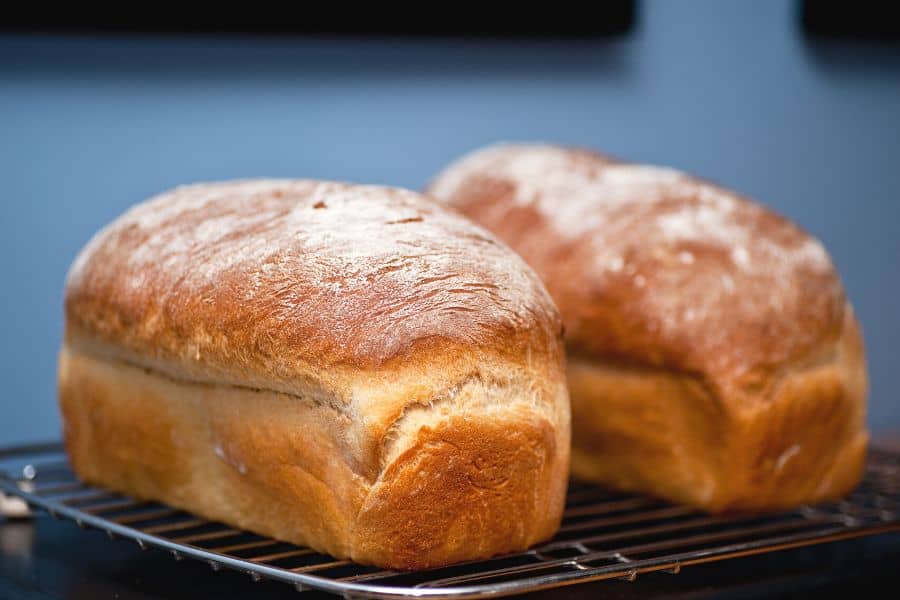Does Bread Make You Fat? What Does Science Say?

Does bread make you fat? | Nutritional details | bread consumption and weight | Tips
Bread is a staple food in many cultures and is often consumed daily. However, this dietary staple has received a lot of flak recently due to concerns that it may contribute to weight gain.
So, does bread make you fat? Recent scientific studies have suggested that it does not. Eating bread does not appear to be associated with an increased risk of gaining weight or becoming obese.
In this article, we will take a closer look at the relationship between bread consumption and weight gain and examine what the science says about the same. We will also explore the nutritional details of different types of bread.
Does bread make you fat?
No, in its absolute basic form, bread does not make you fat. The primary ingredients that go into the making of bread are:
- Flour
- Water
- Salt
- Yeast
None of these are inherently unhealthy or fattening. Nevertheless, it is possible to gain weight from eating too much of any food, including bread.
Additionally, one must also remember that most commercial breads are processed and contain added fats, sugars, and other preservatives. These can contribute to weight gain if consumed in excess.
Alternatively, healthier varieties of bread, like whole wheat bread, multi-grain bread, or sourdough bread, are unlikely to cause unhealthy weight gain.
Nutritional details of different types of bread
Understanding the nutritional profile of different kinds of bread can help you make better choices when it comes to your diet.
We have analyzed 4 of the most commonly consumed types of bread to help you make an informed decision. Use the nutritional data below to decide how much bread you can consume without risking unhealthy weight gain.
Note: All values provided below have been sourced from USDA
1. White bread
White bread is possibly the most commonly consumed and least healthy type of bread. This bread is made from highly processed, refined wheat flour (with the bran and the germ layers removed).
The nutritional profile [1]U.S. Department of Agriculture: WHITE BREAD of one slice of white bread is as follows:
- Calories: 120 kcal
- Protein: 4 grams
- Carbs: 32 grams
- Fiber: 0.9 gram
- Sugars: 2 grams
- Fat: 1.5 grams
- Iron: 0.499 mg
- Calcium: 20.2 mg
- Potassium: 60.2 mg
- Sodium: 240 mg
Thanks to the use of refined grains the production of white bread, it has been variously linked to type 2 diabetes, bad cholesterol, and risk of cardiovascular diseases.
In fact, according to a study, people who consumed 7-10 slices of refined white bread per day were 33% more likely to be at risk of cardiovascular diseases [2]Johns Hopkins Medicine: Whole Wheat Better for You Than White Bread, Study Confirms than those who consumed 2 slices or less.
2. Wholewheat
“Make half your grains whole grains,” suggests a directive by the USDA [3]U.S. Department of Agriculture: MAKE HALF YOUR GRAINS WHOLE GRAINS. Whole wheat bread falls under this category.
Basically, whole wheat bread is made from flour with the bran and germ layers intact, thus making it very rich in dietary fiber, B vitamins, folate, and various minerals.
Whole grain products like whole wheat bread have been linked to slower glycemic responses (low blood sugar spikes) and as much as 25% lower risk of coronary heart disease.
Here is a nutritional split-up [4]U.S. Department of Agriculture: WHOLE WHEAT BREAD of a single slice of whole wheat bread:
- Calories: 80 kcal
- Protein: 5 grams
- Carbs: 20 grams
- Fiber: 3.01 grams
- Sugars: 4 grams
- Fat: 0 gram
- Iron: 1 mg
- Calcium: 9.03 mg
- Magnesium: 31 mg
- Potassium: 95 mg
- Sodium: 170 mg
3. Multigrain bread
Multigrain bread is a type of bread that is made of two or more grain types. The most commonly used grains include rye, barley, oats, and millet.
This type of bread is more nutritionally dense than white bread or even whole wheat bread since it combines the nutritional goodness of more than one grain.
Here is the nutritional information [5]U.S. Department of Agriculture: Bread, multi-grain (includes whole-grain per slice of multigrain bread:
- Calories: 68.9 kcal
- Protein: 3.48 grams
- Carbs: 11.3 grams
- Fiber: 1.92 grams
- Sugars: 1.66 grams
- Fat: 1.1 grams
- Iron: 0.65 mg
- Calcium: 26.8 mg
- Magnesium: 20.3 mg
- Potassium: 59.8 mg
- Sodium: 99.1 mg
However, it is important to remember that not all commercially sold multigrain bread is made of whole grains. Some might be highly processed and may include added fats, preservatives, and sweeteners.
If you wish to buy multigrain bread, ensure that you are buying a whole-grain bread loaf and not a refined one.
4. Sourdough bread
Sourdough bread is a type of bread that uses a fermented sourdough culture as a leavening agent instead of commercial yeast.
It is believed that sourdough bread has a milder effect on blood sugar levels. This is because the fermentation process in sourdough breaks down gluten and starches, making it easier to digest and preventing blood sugar spikes. This makes sourdough bread safe for people on a gluten-free diet as well.
Nutritionally, sourdough bread does not differ much from other breads. Here is the nutritional data [6]U.S. Department of Agriculture: SOURDOUGH BREAD available per slice of sourdough bread:
- Calories: 120 kcal
- Protein: 5 grams
- Carbs: 23 grams
- Fiber: 0.98 gram
- Sugars: 0 gram
- Fat: 1 gram
- Iron: 1 mg
- Calcium: 7.84 mg
- Potassium: 39.2 mg
- Sodium: 220 mg
Studies on the relationship between bread consumption and weight
Analyzing the relationship between bread consumption and weight gain can lead one into a confusing maze of studies, observations, and claims.
The results of various studies show mixed conclusions about bread consumption, weight gain, obesity, and other related health risks.
Here is a broad analysis of the existing information on the subject:
Bread and weight loss
While the traditional advice has been to cut all bread while on a diet to lose weight, considerable research has proven that bread can still be included in a healthy diet for losing weight.
Generally, whole grain bread with higher fiber and lower glycemic index is best suited for anyone aiming for weight loss. A study [7]ScienceDirect: Whole Wheat Bread conducted on Japanese subjects demonstrated that a diet comprised of whole wheat bread resulted in a visible decrease in visceral (abdominal) fat.
This type of bread helps to provide satiety and improve digestion, thus leading to fewer snacking cravings and subsequent promotion of consistent weight loss progress.
It goes without saying that portion control is non-negotiable when it comes to weight loss.
Bread and weight gain
The associations between bread and weight gain are largely linked to the quantity of consumption. Bread can be a safe source of carbs and calories essential for energy needs, but overconsumption has been linked with weight gain.
Ingredients also play a role in whether or not bread can make you fat. Refined bread, such as white bread, tend to lack fiber and protein, which makes them less satiating, leading to excess consumption.
Moreover, as mentioned earlier, refined bread usually contains added sugars which makes it unsuitable for people on a weight loss diet.
Tips to consuming bread in a healthy and balanced diet
Here are a few tips to help you include bread in a healthy and balanced diet:
- Portion control is the key. Too much of any food can make you gain weight. A standard serving size is 2-3 slices per meal.
- If you are aiming for weight loss, try fiber-rich, gut-healthy breads like pumpernickel, multigrain, and whole wheat.
- Consider swapping your regular wheat bread for sprouted grain bread. It is low in sugar and high in fiber.
- Make sure you are getting enough protein and fiber in your diet. These two macronutrients are essential for maintaining a healthy weight.
- Pair your bread with nutrient-dense and satiating sides like fresh veggies, fruits, and lean proteins.
- Avoid adding too many condiments, such as butter or jam, as they are high in calories.
- Make sure you are getting your recommended intakes of vitamins and minerals from other sources as well.
- Always check the nutrition label before buying any bread to make sure it does not contain unhealthy ingredients.
Conclusion
In conclusion, does bread make you fat? Not necessarily. As with all things, moderation is key when it comes to the consumption of bread. It is also important to remember that different types of bread have different nutritional values.
Besides portion control, it is important to choose the right type of bread and pair it with nutrient-dense and satiating sides, such as fresh veggies and lean proteins.
References
| ↑1 | U.S. Department of Agriculture: WHITE BREAD |
|---|---|
| ↑2 | Johns Hopkins Medicine: Whole Wheat Better for You Than White Bread, Study Confirms |
| ↑3 | U.S. Department of Agriculture: MAKE HALF YOUR GRAINS WHOLE GRAINS |
| ↑4 | U.S. Department of Agriculture: WHOLE WHEAT BREAD |
| ↑5 | U.S. Department of Agriculture: Bread, multi-grain (includes whole-grain |
| ↑6 | U.S. Department of Agriculture: SOURDOUGH BREAD |
| ↑7 | ScienceDirect: Whole Wheat Bread |







